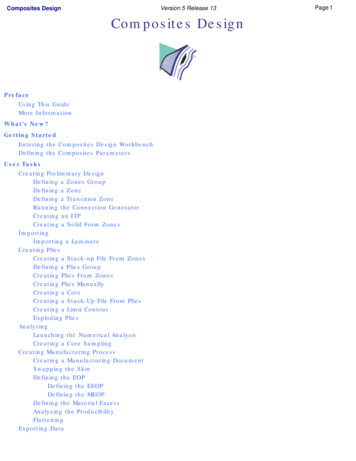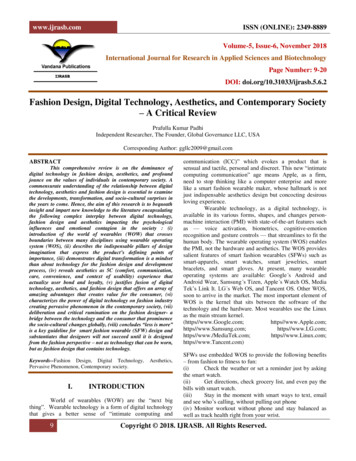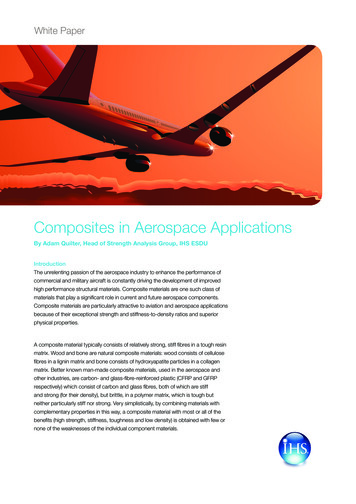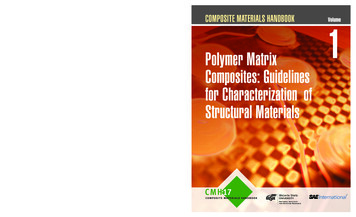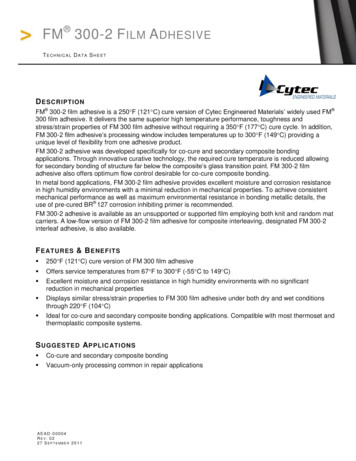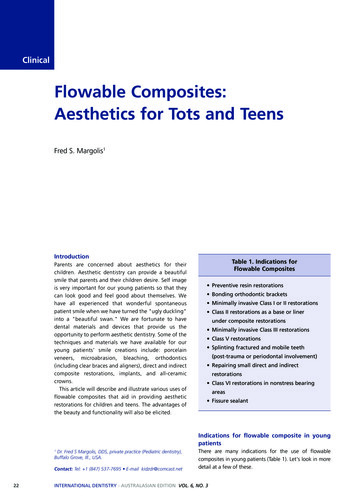
Transcription
ClinicalFlowable Composites:Aesthetics for Tots and TeensFred S. Margolis1IntroductionParents are concerned about aesthetics for theirchildren. Aesthetic dentistry can provide a beautifulsmile that parents and their children desire. Self imageis very important for our young patients so that theycan look good and feel good about themselves. Wehave all experienced that wonderful spontaneouspatient smile when we have turned the "ugly duckling"into a "beautiful swan." We are fortunate to havedental materials and devices that provide us theopportunity to perform aesthetic dentistry. Some of thetechniques and materials we have available for ouryoung patients' smile creations include: porcelainveneers, microabrasion, bleaching, orthodontics(including clear braces and aligners), direct and indirectcomposite restorations, implants, and all-ceramiccrowns.This article will describe and illustrate various uses offlowable composites that aid in providing aestheticrestorations for children and teens. The advantages ofthe beauty and functionality will also be elicited.Table 1. Indications forFlowable Composites Preventive resin restorations Bonding orthodontic brackets Minimally invasive Class I or II restorations Class II restorations as a base or linerunder composite restorations Minimally invasive Class III restorations Class V restorations Splinting fractured and mobile teeth(post-trauma or periodontal involvement) Repairing small direct and indirectrestorations Class VI restorations in nonstress bearingareas Fissure sealantIndications for flowable composite in youngpatients1Dr. Fred S Margolis, DDS, private practice (Pediatric dentistry),Buffalo Grove, Ill., USA.Contact: Tel: 1 (847) 537-7695 E-mail kidzdr@comcast.net22There are many indications for the use of flowablecomposites in young patients (Table 1). Let's look in moredetail at a few of these.INTERNATIONAL DENTISTRY - AUSTRALASIAN EDITION VOL. 6, NO. 3
ClinicalabFigure 1a. Permanent molar with incipient caries. (Courtesy ofGiovanni Olivi)aFigure 1b. Preventive resin restoration. (Courtesy of Giovanni Olivi)bFigure 2a. Permanent molar with caries adjacent tofailed sealant. (Courtesy of Giovanni Olivi)Figure 2b. Erbium laser preparation of molar forpreventive resin restoration. (Courtesy of Giovanni Olivi)cFigure 2c. Preventive resin restoration. (Courtesy ofGiovanni Olivi)Preventive Resin Restorations1Simonsen has recommended that, for the type 2preventive resin restorations (PRR) in which the preparationinvolves both the enamel and dentin, a flowablecomposite could be utilized to replace the carious toothstructure after excavation of the incipient caries. In aFigure 3. Bonded orthodontic brackets.recent article by Savage, et al2 it was reported thatflowable composite was the most widely used restorativematerial for the PRR among those pediatric dentistssurveyed in this study. More than 30% of the pediatricdentists always use a flowable composite or a combinationof flowable composite and "packable" composite/INTERNATIONAL DENTISTRY - AUSTRALASIAN EDITION VOL. 6, NO. 323
Margolisflowable composite combination (Figures 1a and 1b).2 Theauthor has found flowable composite to also be usefulwhen a sealant has failed and incipient caries has beendetected at a recall visit (Figures 2a to 2c). The VenusDiamond Flow (Heraeus Kulzer) flowable composites offerlow shrinkage and high flexural strength.Bonding Orthodontic Brackets3Vicente and Bravo evaluated the shear bond strength ofseveral flowable composites after debonding oforthodontic brackets compared to a traditionalorthodontic resin. The shear bond strength was measuredwith a universal testing machine and the adhesiveremnant after debonding was quantified utilizing imageanalysis. The results showed that there were no significantdifferences between the shear bond strengths of thevarious groups evaluated. The orthodontic resin leftsignificantly more adhesive on the tooth than the 3aFigure 4a. Class II preparation on a primary molar.cFigure 4c. Flowable composite restoration completed.24flowable composites tested.3 Ryou, et al4 in a recent studyconcluded: “.flowable composites with no intermediatebonding resin could be conveniently applied fororthodontic bonding” (Figure 3).Class II and V Restorations Utilizing FlowableCompositeFlowable composites are often utilized as a liner undercomposite restorations. The purpose is to seal themargin, which helps prevent postoperative sensitivity andsecondary caries. Sadeghi and Lynch5 investigated theeffects of a layer of flowable composite and compomeron microleakage of composite restorations that extendedapically to the cement-enamel junction. The results of thestudy showed that when flowable composites were usedas a liner, both the packable and the nanofilledcomposite materials had significantly less microleakagethan when flowable liners were not used. There was abFigure 4b. Flowable composite placed.aFigure 5a. Class II preparations of bicuspid and molars.INTERNATIONAL DENTISTRY - AUSTRALASIAN EDITION VOL. 6, NO. 3
MargolisbFigure 5b. Flowable composite as a liner.a26cFigure 5c. Composite placed over flowable composite.bFigure 6a. Class V preparation on bicuspid.Figure 6b. Flowable composite restoration.significant reduction of the microleakage occurring underboth types of composite materials at the gingival floors5(Figures 4a to 6b).Illie and Hickel6 investigated the mechanical propertiesof composites and concluded that flowable compositesand compomers showed comparable results. Flowablecomposites only differed from microfilled composites indiametric tensile strength.Some of the flowable composites the author usesroutinely includes Venus Diamond Flow. The advantages tothis particular flowable composite includes the increasedstrength (versus a sealant), low shrinkage stress, and highflexural strength. It also has the advantage of being anexact shade match with the Venus Diamond compositesystem. Other flowable composites that the author usesincludes G-aenial Flo and Universal Flo (GC Corporation)and Beautifil Flow Plus (Shofu). The advantage to the lateris the release of fluoride. Vertise Flow (Kerr) has the addedbenefit of being self-etching.The effects of different light-curing units on themicroleakage of flowable composite resins was studied byYazici, et al.7 They found that none of the Class Vrestorations restored with flowable composites exhibitedmarginal leakage of the enamel. Also, there was nosignificant difference exhibited between the flowablecomposites tested on the dentin margins.7INTERNATIONAL DENTISTRY - AUSTRALASIAN EDITION VOL. 6, NO. 3
MargolisaFigure 7. Splint bonded with a flowable composite.Figure 8a. Fractured permanent central incisor.bFigure 8b. Flowable composite bonded fractured segment to crown.Figure 9. Orthodontic retainer bonded with flowable composite.Splinting Fractured and Mobile Teeth andOrthodontic Retainersnylon filament splints (Ribbond). Foek, et al9 studied theadhesive properties of bonded orthodontic retainers toenamel, utilizing flowable composite, with both stainlesssteel wire versus fiber-reinforced composites. They foundthat the bond strengths between the fiber-reinforcedcomposites and the orthodontic wire when used asretainers did not differ significantly (Figures 7 to 9).9Tabrizi, et al8 found that flowable composites providedsatisfactory shear bond strength comparable to a standardorthodontic resin and therefore may be used for directbonding of lingual retainers.8 Flowable composites may beused to splint mobile teeth utilizing orthodontic wire or28INTERNATIONAL DENTISTRY - AUSTRALASIAN EDITION VOL. 6, NO. 3
MargolisFigure 10. Occlusal restoration with Venus BulkFlowable.Figure 11. Radiopacity of a flowable composite material.Repairing Small, Direct, and IndirectRestorationsOne of the many advantageous properties of flowablecomposites is their ability to repair previously placedcomposite restorations. Papacchini, et al10 evaluated theeffect of various intermediate resin agents oncomposite-to-composite bond strengths. The flowablecomposites showed good interfacial quality to theadhesives. Also, the application of flowable compositesresulted in statistically superior tensile strength (Figure10). 10 The author used Venus Diamond Flow in thisinstance due to the studies indicating its excellent bondstrength, low shrinkage stress, and shade matchingquality.Table 2. The Desirable Properties of Flowable Composite are the following: Flowable consistency and modeling (thixotropic) Low shrinkage Radiopaque Shades corresponding to composites; color adaptative qualities Polishability and long-lasting shine Color stability30INTERNATIONAL DENTISTRY - AUSTRALASIAN EDITION VOL. 6, NO. 3
MargolisImportant properties of flowable compositesFlowable composites exhibit many characteristics thatmake them an excellent choice for indications like the oneshighlighted above (Table 2). The following properties areimportant when treating young patients with this class ofcomposite resin restorative material.2. Savage B, McWhorter AG, Kerins CA, et al. Preventive resinrestorations: practice and billing patterns of pediatric dentists.Pediatr Dent. 2009;31:210-215.3. Vicente A, Bravo LA. Evaluation of different flowablematerials for bonding brackets. Am J Dent. 2009;22:111-114.4. Ryou DB, Park HS, Kim KH, et al. Use of flowable compositesfor orthodontic bracket bonding. Angle Orthod. 2008;78:1105-Radiopacity of Flowable CompositesOne of the qualities of a flowable composite that is veryfavorable is that of being radiopaque. Venus Diamond Flowhas been shown to be one of the most radiopaqueflowables on the market today. Murchison, et al11 in theirstudy, stated the following: "The level of radiopacity of thetested flowable composites was variable; those with lowradiodensity should be avoided in Class II restorations,where a clear determination of recurrent caries by theexamining clinician could be compromised."11 Sabbagh, etal12 agreed with a more recent study when they concludedthat flowable composites used within intracoronalrestorations, clinicians should use materials with highradiopacity (Figure 11).121109.5. Sadeghi M, Lynch CD. The effect of flowable materials onthe microleakage of Class II composite restorations that extendapical to the cemento-enamel junction. Oper Dent. 2009;34:306311.6. Ilie N, Hickel R. Investigations on mechanical behaviour ofdental composites. Clin Oral Investig. 2009;13:427-438.7. Yazici AR, Celik C, Davangac B, et al. Effects of different lightcuring units/ modes on the microleakage of flowable compositeresins. Eur J Dent. 2008;2:240-246.8. Tabrizi S, Salemis E, Usumez S. Flowable composites forbonding orthodontic retainers. Angle Orthod. 2010;80:195-200.9. Foek DL, Ozcan M, Krebs E, et al. Adhesive properties ofbonded orthodontic retainers to enamel: stainless steel wire vsfiber-reinforced composites. J Adhes Dent. 2009;11:381-390.Polishing Flowable Composites10. Papacchini F, Radovic I, Magni E, et al. Flowable compositesPolishablilty of the surface of the restoration is importantfor aesthetic and functional purposes. The surface shouldbe able to have a smooth lustrous surface and be able tomaintain this desired characteristic. Ozel, et al13 studied theeffect of one-step polishing systems on the surfaceroughness of various flowable composites. The one- or 2step polishing systems are a good choice for the polishingof flowing composites.13as intermediate agents without adhesive application in resinConclusionpolishing systems on surface roughness of different flowableThis article briefly described and demonstrated variousindications for aesthetic restorations that can be usedsuccessfully for our child and adolescent patients. Modernaesthetic techniques and flowable composite resinmaterials, used properly for purposes such as thosepresented herein, will serve to broaden the scope ofaesthetic dentistry delivered for children and teens.restorative materials. Dent Mater J. 2008;27:755-764.composite repair. Am J Dent. 2008;21:53-58.11. Murchison DF, Charlton DG, Moore WS. Comparativeradiopacity of flowable resin composites. Quintessence Int.1999;30:179-184.12. Sabbagh J, Vreven J, Leloup G. Radiopacity of resin-basedmaterials measured in film radiographs and storage phosphorplate (Digora). Oper Dent. 2004;29:677-684.13. Ozel E, Korkmaz Y, Attar N, et al. Effect of one-stepReferences1. Simonsen RJ. Preventive resin restorations (II). QuintessenceInt Dent Dig. 1978;9:95-102.32Disclosure: Dr. Margolis receives honoraria and productsfrom Biolase Technologies, Inc.Reprinted by permission of Dentistry Today, c2011Dentistry Today.Flowable Composites: Aesthetics for Tots and Teens, byFred S. Margolis, DDS: Dentistry Today, Vol. 30, No. 4,04/11, pp 132-137.INTERNATIONAL DENTISTRY - AUSTRALASIAN EDITION VOL. 6, NO. 3
Disclosure : Dr. Margolis receives honoraria and products from Biolase Technologies, Inc. Reprinted by permission of Dentistry Today, c2011 Dentistry Today. Flowable Composites: Aesthetics for Tots and Teens, by Fred S. Margolis, DDS: Dentistry Today, Vol. 30, No. 4, 04/11, pp 132-137. 32 INTERNATIONAL D
